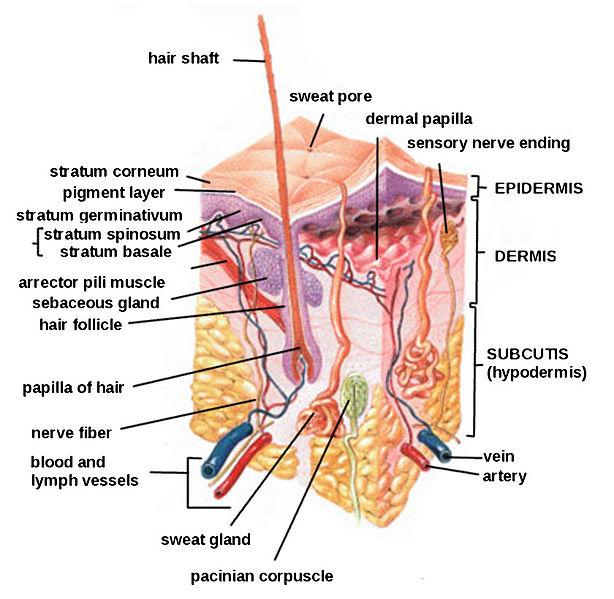In order to under the basic of aesthetic treatments, it is helpful to understand the skin anatomy. Mammalian skin is composed of many layers, each of which has a specific function. The two primary layers are the epidermis and the dermis but there is a lot more going on between and beneath these two layers. In the following diagram we can see that the epidermis makes up about 25% of the skin’s thickness while the dermis makes up the rest of the thickness and contains things like hair follicles and nerve fibers.

Epidermis
As the outermost layer of skin, the epidermis provides waterproofing and also serves as a barrier to infection. It helps the skin regulate body temperature and is primarily made up of keratinucytes which account for 95% of the cells of this layer. The layer also contains Merkel cells, melanocytes, and Langerhans.
The epidermis can be further divided up into sub levels as shown in the above image. These levels are:
- Stratum corneum (the pigment layer);
- Stratum lucidum (only present in the palms of the hand and soles of the feet);
- Stratum granulosum;
- Stratum spinosum; and
- Stratum germinativum or stratum basale.
The epidermis contains no blood vessels, instead the cells in the deepest levels are nourished by blood capillaries extending to the upper levels of the dermis.
The basement membrane is a thin sheet of fibers which controls cell and molecule traffic between the dermis and the epidermis. It is also a reservoir for controlled release of necessary cells during physiological remodeling or repair processes.
Dermis
A thicker layer of skin situated underneath the basement membrane, the dermis consists of connective tissues which cushion the body from stress and strain and provide tensile strength and elasticity to the skin through an extracellular matrix composed of collagen fibrils and elastic fibers embedded in proteoglycans.
Below the dermis lies the papillary region which is composed of loose areolar connective tissue. This gives the dermis a bumpy surface, strengthening the connection between the two layers of skin. Deep in this region lies the reticular region which is much thicker and composed of dense, irregular connective tissue. It is within this region that one finds the roots of hair, sebaceous glands, sweat glands, receptors, roots of nails, and blood vessels.
Hypodermis
Not part of the skin, the hypodermis lies below the dermis and attaches the skin to the underlying bone and muscle. It supplies the skin with blood vessels and nerves and consists of loose connective tissue and elastin. The hypodermis is also known as subcutaneous tissue.
(Source)
